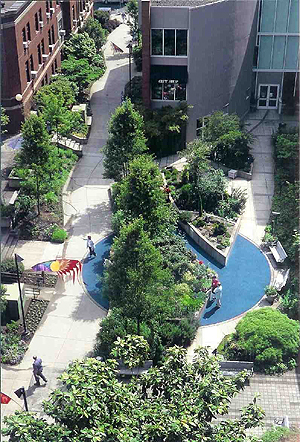
DJC.COM
November 16, 2006
Hospital gardens help patients heal
ESA Adolfson

Epstein
|
In the 20th century, medical advances in treatment, surgery and medicines brought cures where before there had only been care.
Patients were recast from self-healing humans to diseased entities that sought the assistance of scientifically trained nurses and doctors in order to recover. In acute-care hospitals the design emphasis shifted toward accommodating the new technologies and to efficiencies like saving steps for physicians and nurses. Design emphasis moved away from attending to the patients’ environment.
There is currently resurgence in the introduction of therapeutic landscapes, evidenced by the creation of therapeutic gardens in many cities, and in public as well as private facilities. Hospital grounds, once considered only landscaped setbacks, are now being utilized to improve patient outcomes, increase positive patient satisfaction surveys and retain staff.
The Joint Commission on Accreditation of Healthcare Organizations has now included access to nature as part of their evaluation. Outdoor space can enhance wayfinding within the building, and several hospital systems use their gardens as a marketing tool.

Photo courtesy of Legacy Health System Healing gardens offer patients a range of therapeutic benefits, including a sense of escape. The garden at the Legacy Good Samaritan Hospital in Portland won the American Horticultural Therapy Association’s first design award in 1998. |
7 characteristics
Physical rehabilitation activities can occur in the garden setting whenever the climate permits patients to be outdoors. Occupational therapists use watering and deadheading flower activities to meet their goals with patients.
Speech pathologists use the garden for cognitive and communication treatments. Recreational therapists find many uses for the gardens including music and other social programming, walking, birdwatching and learning adaptive gardening strategies.
The horticultural therapist uses the garden to help patients increase strength and endurance, mobility, focus and memory. The garden can also encourage use of adaptive strategies and development of new leisure interests.
In 1995 the American Horticultural Therapy Association developed the following “characteristics of therapeutic landscapes”:
• Features are modified to improve accessibility. Alzheimer’s residents enjoy sitting to work with staff to deadhead annuals in containers and are able to work at raised beds. Children also are able to work effectively from wheelchairs into the various raised beds. The grade of the garden allows for challenge activities; spinal cord injury clients with greater upper extremity function are able to reach the top of the healing garden, while frail elders may propel their wheelchairs independently only near the entrance to the garden.
• Edges of garden spaces and special zones of activities within the garden are intensified to direct the attention and energies of the user into the garden.
• A profusion of plants and people/plant interactions is essential. Lush, rich botanical collections with great variety are absolutely critical to therapeutic applications both in horticultural therapy and to those who use the garden independently.
• Therapeutic goals focus on mobility, motor skills, social interaction, cognitive ability and emotional status. Restorative goals promote general well-being, with focus on play, relaxation, socialization, education and creativity.
• Benign and supportive conditions are identifiable. Plants are selected for, among other characteristics, their disease and pest resistance, thereby avoiding potentially hazardous chemicals.
• In the hospital garden setting, it is important to design and program for the widest possible range of user abilities. Therapeutic gardens commonly stimulate the full range of senses — memory, hearing, touch, smell and sometimes taste — as necessary supplements to the visual experience.
• Therapeutic gardens in the hospital setting should be simple, unified and easily comprehended places.
Sense of escape
Post-occupancy evaluations of hospital gardens have indicated the high value placed on access to the outdoors by staff, visitors and patients alike.
Among the garden elements most valued are features that represent life and health, such as trees, plants and flowers; and elements that arouse the senses, such as fragrances, the sounds of birds and water, and the feel of sunlight or a gentle breeze.
These elements represent a marked contrast to most hospital interiors, providing a sense of distance or escape, while allowing for reflection and restoration.
Certain factors can limit the benefits of gardens. These include lack of information on a garden’s location and accessibility; insensitivity to specific patient mobility needs; intrusive sensory stimuli (such as noise and allergic pollens); lack of accommodation for competing user needs (including smoking areas and the desire for fresh air); and design elements that evoke mixed or ambiguous interpretations.
This last is particularly significant in a medical setting, where the fragile emotional state of many users predisposes them to place negative meanings on many things except the most unambiguously positive stimuli. Gardens in medical settings need to be tailored to meet the particular needs of their specific patient populations. This is best done in conjunction with a design team of patients and relatives, staff and administrators.
Mark Epstein is a landscape architect with ESA Adolfson in Seattle and co-chair of the ASLA Healthcare and Therapeutic Design Professional Practice Network.
Other Stories:
- New law encourages hospitals to give patients a lift
- Hotels offer lessons for Oregon hospital
- State to adopt national health care design standards
- Quick! Turn an office building into a medical center
- Complex projects call for virtual construction
- Build a better building with 3-D modeling
- Boomers shaping future of health care design
Copyright ©2009 Seattle Daily Journal and DJC.COM.
Comments? Questions? Contact us.